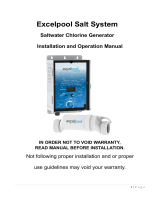
Page 17
ENGLISH
Jandy
®
Pro Series TruClear
™
Chlorine Generating System
|
Installation & Operation Manual
4.5 Collecting a Water Sample
To properly collect a water sample for use with your
home test kit or to be taken to local pool dealer there are
some good practice suggestions that should be followed.
Never use glass containers in the pool area.
Choose a location well away from the return ttings that
are bringing water back to the pool.
Take the container and turn it upside down to trap air
and then turn the container upright 46 cm (18 in.) below
the surface of the water. Bring container to the surface
and cap the container.
4.6 Salt (NaCI Sodium Chloride)
When to add salt
Add salt to the pool if the salt is too low (see Table 1).
For a new pool or newly resurfaced pool it is
recommended to wait at least 30 days (surface should
be completely cured) before adding salt. Do not run
the chlorinator at this time. Manually chlorinate the
pool. Contact your dealer for recommendations. Follow
the pool surface manufacturer’s guidelines for your
particular pool. For vinyl and berglass pools, salt can
be added at start up.
What Type of Salt to Use
• The purer the salt, the better the life and performance
of the electrolytic cell. Use a salt that is at least
99.8% pure NaCl. The salt is an evaporated,
granulated, food quality, non-iodized salt. Consult
your pool store.
• Avoid using salt with anti-caking agents (sodium
ferrocyanide, also known as YPS or yellow prussiate
of soda) that could cause some discoloration of
ttings and surface nishes in pool.
• Water conditioning salt pellets are compressed forms
of evaporated salt and may be used but will take
longer to dissolve.
• Do not use calcium chloride as a source of salt. Use
sodium chloride only.
• Do not use rock salt because insoluble impurities
mixed with the rock salt can shorten the life of the
unit.
How Much Salt to Use
Use salinity test strips, a TDS/salinity meter, or another
reliable method to test the salinity of the pool water. Once
the existing salinity has been established, use Table 1 to
determine the amount of salt to add to reach the desired
level. Be conservative when adding salt as it is easier to
add more if needed than it is to dilute if there is too much
salt.
• 3,000 ppm of salt is recommended for optimum
water conditions.
• Low salt concentration below 2,500 ppm will cause
premature cell failure.
• High salt concentration above 6,000 ppm may cause
corrosion damage to pool xtures.
CAUTION
It is important to note that certain materials used
in and around swimming pools and spas may not
be compatible with chemicals commonly used to
purify pool and spa water (e.g. acids, chlorine, salt,
stabilizers, etc.).
Zodiac Pool Systems, Inc. does not warrant or
guarantee that the chlorinated water generated by
the Jandy Pro Series chlorine generating device
will not damage or destroy certain types of plants,
decking, coping and other materials in and around
your pool and/or spa. Before selecting materials to
be used in and around your pool and/or spa, please
discuss all options with your contractor to assess the
compatibility of such materials and chemicals. When
mixing acid with water, ALWAYS ADD ACID TO
WATER. NEVER ADD WATER TO ACID.
Some helpful considerations may include:
• Choosing plants that can withstand splash out of
pool water containing chlorine and/or salt and other
waterpuricationchemicals.
• All metal components used in and around a
pool should be of a high grade, quality stainless
steel.
• Careful selection of masonry products. The porosity
and hardness of natural stones varies greatly.
Therefore we recommend you consult with your
builder or stone contractor on the best choice for
stone materials around your pool or spa.
• Sealing all masonry products. Professionals
in the stone industry specify that even natural
stone, especially when used outdoors, be sealed
to prevent weathering, staining, and premature
degradation. Consult with your stone or deck
contractor for the proper sealer for the masonry
products you have selected to use around your
pool or spa.
• For optimal results, sealers should be reapplied on
a regular basis. Reapply the protective sealer on a
schedule per the manufacturer’s instructions.
• Use of chemicals other than those recommended
may be hazardous. Follow the chemical
manufacturers instructions.























